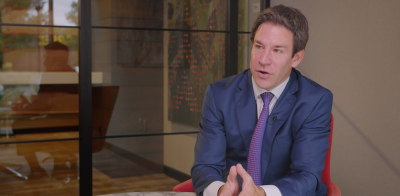Since we have now moved into a Fed easing cycle (at least with the Fed Funds rate and the front end of the yield curve since the Fed is still shrinking their balance sheet and technically still draining liquidity from markets and the economy), I thought it made sense to revisit one of the most attractive investment themes of the past six to seven years: Using appropriate alternative strategies to replace or complement fixed income.
Kicking the tires on bonds and duration
If you are a financial advisor, institutional investor, sophisticated investor or relative newcomer, I am sure you have been bombarded by long-only fixed income managers talking up bonds and duration1 since long prior to the 10-year Treasury yield hitting 5% last year. (Heck, as soon as the 10-year breached 2% in 2022, the drumbeats began, reaching true cacophony as the 10-year yield dropped to a recent low of 3.62% immediately prior to the Fed commencing their Fed funds rate 50bps cut last month.)
The logic behind this “you gotta drop everything and buy bonds” herd mentality was that, since the Fed is going to cut rates, long end yields should drop, too (which never made any sense in a non-recessionary outcome, by the way). Or somewhat more rationally (key word, somewhat), front end rates are going to drop at some point by either a little or lot, so you better flee cash and lock in those “awesome” low 4% or high 3% yields today! Anybody need a used car? We have a stunning ’82 Chevy Cavalier on special that only has 80,000 miles on it (because no one has wanted to drive it for 30 years—or ever for that matter). But trust me, that 4-cylinder, 2L, naturally aspirated (talk about a euphemism) 100 HP, 80 foot pounds of torque, marvel of American engineering can comfortably accelerate this beauty to 65 mph in under 20 seconds—at which point the car will still avoid disintegrating on I-80 (but you should probably stay under 70 just to be safe). And don’t get me started on how smooth the 3-speed automatic transmission seamlessly distributes that power when you need it! Man, do I miss my old ’82 Chevy Cavalier (not really).
Not to confuse bond permabulls with used car salesmen (hey, used car salesmen can be clients, too—and anyway bond permabulls tend to have fancier degrees, nicer watches and typically drive new cars), but when choosing between a beat-up American used car masterpiece or chasing duration with a still well below Fed funds rate 10-year Treasury yield, well, at least you can drive a car.
Why not chase duration?
As you know from reading previous strategy notes (or if you’ve caught any of my media appearances over the past six months), we have been warning investors for quite some time NOT TO CHASE DURATION as 10-year yields plummeted below 4% and the 10-year yield once again plumbed historic lows relative to the Fed funds rate. The reason for the warning was the following: Barring an exogenous shock where the Fed had to take the front end to 0%–1%, you basically had no upside, still relatively little yield and the potential (which has now been experienced to some extent…yet again) of a duration-driven mark-to-market loss.
The logic which held one, three and six months ago was pretty simple, and we believe, somewhat unassailable: As the Fed cuts rates and gradually takes the front end to 3%, the yield curve will do what it always does…steepen and potentially steepen dramatically. And guess what, the Fed cut by an arguably unnecessary 50bps (25bps made more economic sense, but the “keep real rates from continuing to rise” rationale won the day), and in a relatively short period of time, the 10-year yield rocketed from 3.62% to over 4.25%.
Since 10-year Treasuries have approximately eight years of duration, an approximate 60bps move equates to a little under a 5% mark-to-market loss. To add insult to injury, the majority of high quality alternative strategies (not including equity REITs) has continued to outperform fixed income—and clearly listed equity markets continue to do well.
The 10-year Treasury yield
To put all of this into context, the slope between the 10-year Treasury yield and the Fed funds rate (10-year yield minus Fed Funds rate) has typically been 1.25% to 1.5% over a full market cycle going back decades; and in sustained economic expansions, there have been times the slope has been 2%–3%, or even as high as close to 4%!
Unlike fixed income permabulls, probably none of us has a PhD in math, but:
3% + 1.37% = 4.37%
3% + 2% = 5%
3% + 3% = 6%
And holy cow, 3% + 4% = 7%!
This is not to argue that the 10-year is going to 7% tomorrow or anytime soon, but it does not take much imagination to see the 10-year yield going materially higher from here as the Fed continues to cut rates. This will obviously lead to rather dramatic mark-to-market losses in long-dated duration, and justifiably very angry clients. (That ’82 Chevy Cavalier is looking better and better in comparison, right?)
Yield curves may get even steeper
Furthermore, for numerous fundamental reasons, yield curves should be even steeper going forward than they have been historically.
- Stronger for longer/Higher for longer: We are clearly in a stronger-for-longer economic environment (consumer in good shape, business fixed investment and cap ex booming; governments at state, local and federal level spending freely) and a higher-for-longer inflationary environment (aging workforce, skills mismatch, onshoring/nearshoring, trade wars/tariffs, resurgence of union power, energy “transition,” geopolitical divergence, etc.).
- Treasury issuance: Unless there is a sea change in our domestic political environment, the U.S. is more than likely going to issue over $20 trillion in Treasuries over the next 10 years—that is, assuming we just continue on our current path of fiscal profligacy, we comfortably avoid recession and there is no need for emergency spending (think Global Financial Crisis or pandemic) in which case issuance will surely be higher. That will be over 72% of the current stock of Treasuries held by the public, which means Treasuries have the worst stock-to-flow ratio of any major asset class by far! Who the heck is going to absorb this supply without the allure of materially higher yields?
- The Fed is draining their balance sheet: Even though the Fed has tapered quantitative tightening,2 they continue to drain their balance sheet at the second fastest pace in history.
- China is unlikely to purchase Treasuries: Last I checked, the geopolitical situation with China has sort of…deteriorated, and even if they had the monetary resources (news flash, they no longer do) to purchase Treasuries as aggressively as they have in the past, it is likely to appear geopolitically unpalatable.
What about municipal bonds?
As I finished writing that last section, I could already hear the pushback, “But Troy, what about munis?”
It is true most long duration municipal bonds (munis) offer higher tax equivalent yields than Treasuries, so you tend to have less duration per unit of maturity, and thus less sensitivity to rates moving higher.
However, the number one driver of market losses (or to be fair, market gains) for longer duration munis over the next several years will be rates moving higher (or lower), which could easily overwhelm one or more years of income. And believe me, I know I’ve been told that every investor buys bonds to hold them to maturity (sure they do) and doesn’t focus at all on short-term losses or gains, but didn’t the 2022 experience teach us the folly of blindly buying duration and believing that investors wouldn’t be upset by substantial mark-to-market losses that would take years to recoup as the long duration bond was gradually pulled to par?
Hedge protection is not enough
Lastly, to be fair to long-duration fixed income, at least you have some hedge protection in case an exogenous shock hits markets and the economy (think China finally invades Taiwan or another pandemic). Additionally, bonds are no longer the epitome of return-free risk (tons of risk, no return potential) like they were at the end of 2021 and early 2022.
But not being the definition of return-free risk and some degree of hedge protection is arguably not enough to make a rather pedestrian level of income (with high levels of duration risk and volatility) a compelling investment opportunity.
Alternative strategies: Commercial real estate lending, corporate private credit and liquid multi-strategy
One of the most compelling use cases for alternative strategies since 2017 has been as a fixed income complement or replacement. Investors that embraced this use case in the past have had a much better outcome than those who clung to duration driven income.
Alternative strategies like senior secured commercial real estate lending and clean vintage corporate private credit with a complementary focus on asset-based lending provide the opportunity for:
- Higher income: Yes, even better than munis on a tax equivalent basis.
- Lower duration: Remember, I would have loved nothing more for floating rate3 private credit strategies than to have had the Fed take the front end to 10% without cratering the economy, but even the mighty U.S. economy has its limits.
- Lower volatility
- Less drawdown risk than in every conceivable environment other than a repeat of 2008.
Which is all to say that, if you are looking for a replacement or complement to fixed income, or a place to put massive client cash hoards to work, it would be very difficult to find more attractive strategies than senior secured commercial real estate lending or clean vintage corporate private credit with a complementary focus on asset-based lending.
And heck, even though purists may argue with moving from fixed income or cash to any equity strategy (given the historical differences in correlation to the economy), public equities and fixed income have been much more highly correlated over the last three years and evergreen middle market private equity strategies have trounced fixed income over any reasonable time horizon (other than 2008 and 2000–2002) with, you guessed it, less volatility, low to no duration and far lower beta than publicly traded equities.
Liquid multi-strategy funds
Lastly, we continue to see strong interest from investors in substituting or complimenting fixed income with liquid multi-strategy funds. This is particularly attractive for those who want to use a highly liquid strategy in lieu of fixed income because they would prefer not to give up any liquidity in their asset allocation for that particular allocation.
Low beta, low-to-no duration, low volatility liquid multi-strategy funds were almost purpose-built to help investors get through this challenging time for fixed income. These funds continue to be an attractive alternative to cash, money market funds and T-Bills, particularly as the Fed continues to cut rates.
What about the impact of Fed cuts?
Lastly, when investors ask me, “How concerned are you about the forward trajectory of the front end of the curve—as the Fed cuts rates, the absolute level of income will drop to some extent for floating rate income strategies?” I answer that, the reality is, I’d actually be rather pleased with either plausible outcome.
- If the Fed does not cut at all anymore (highly unlikely), then investors will enjoy an even higher absolute level of income than expected.
- If the Fed brings the front end to 3% by the summer of 2025 (again highly unlikely) or by the end of 2026 (far more plausible), then the absolute level of income will drop, but the relative income to risk-free will rise. This is because most floating rate alternative strategies have a beta/sensitivity to the front end of the curve/fed funds rate of somewhere between 0.25 at the low end, and 0.5 at the high end. Thus, for every 100bps of rate cuts (all other things being equal, such as spreads and balance sheet utilization), income should only drop by 0.25%–0.5% and the spread to risk-free increases.
Conclusion: Alternatives offer viable options for replacing/complementing fixed income
So, fight inertia! The more things change, the more they stay the same, and the generational challenge to replace or complement fixed income will be with us for many years.
Fortunately, you now have viable options that are super user-friendly for accredited or qualified clients and above. It’s another compelling outcome of the democratization of alts.
Investing in alternatives is different than investing in traditional investments such as stocks and bonds. Alternatives tend to be illiquid and highly specialized. In the context of alternative investments, higher returns may be accompanied by increased risk and, like any investment, the possibility of an investment loss. Investments made in alternatives may be less liquid and harder to value than investments made in large, publicly traded corporations. When building a portfolio that includes alternative investments, financial professionals and their investors should first consider an individual’s financial objectives. Investment constraints such as risk tolerance, liquidity needs and investment time horizon should be determined.



